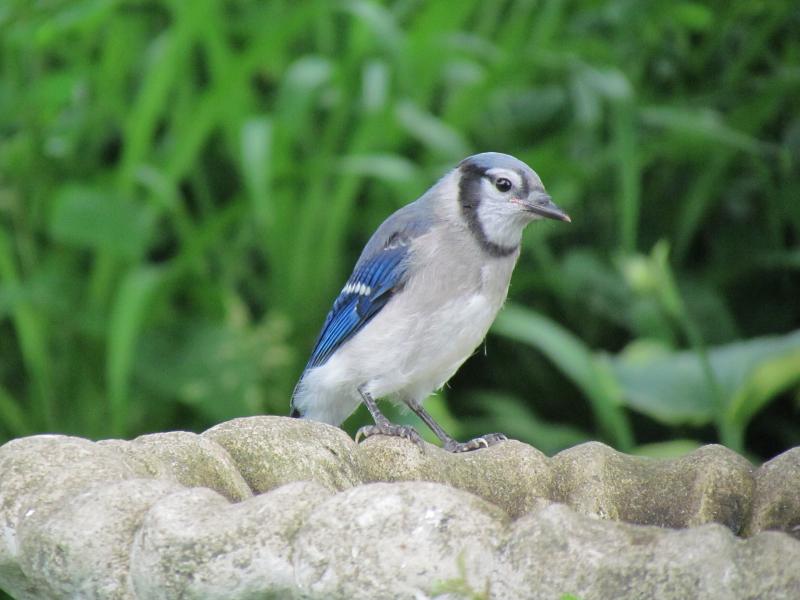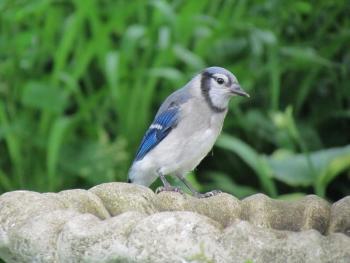The Familiar and Fascinating Blue Jay
It should come as no surprise to learn that some of the greatest mysteries of the bird world are within some of our most common and familiar birds. Take the ever-present blue jay, for example. On a recent trip to Monhegan Island by one of us (Jeff. Leading a tour for LL Bean’s Outdoor Discovery School), saw high-flying flocks of blue jays leaving the island toward the mainland, about 10 miles distant. This was the case throughout the day. The group estimated that the total number of jays in migration was at least 80, probably more likely over 100.
Around the same time, a number of birders from around the state posted on the Maine Birds listserve that they too had been noticing flocks of migrating blue jays, in larger numbers than usual.
Many people are surprised to learn that blue jays migrate. That’s because most blue jays apparently don’t migrate. And even if some do, most of us always have some blue jays hanging around in our backyards and coming to our feeders throughout the year.
But birders have long known that in both spring and fall, it’s not uncommon to see flocks of high-flying blue jays clearly zipping off in migration. At official hawk watches, observers often keep tally of the number of blue jays passing by along with the hawks. The numbers can sometimes (especially in fall migration) be in the thousands that pass by certain spots daily during the height of migration. Blue jays, as far as we know, only migrate during the day like their Corvid cousins, American crows.
According to the blue jay account in Cornell’s “Birds of the World,” it’s still unknown whether or not most migrant blue jays are young birds, since banding station captures during migration in some years seem to have lots of young jays—but not in every year. It’s also still unknown as to whether there is a component of the population that migrates every year from every part of the range or whether movements are related to food abundance changes in some areas in some years. We have wondered whether it may be that birds along the northern edge of the blue jay range within the Boreal Forest biome of Canada could be the ones that vacate that very cold area each winter. But there is no clear evidence for that being the case.
And despite the large numbers of blue jays that are seen migrating south each year, even into Florida and across into Gulf Coast states and Texas, there has never been a documented record of the species from Mexico or the Caribbean (according to “Birds of the World,” at least). Interestingly, there is a photographic record in eBird of a blue jay coming to a feeder in south Texas, just barely across the Rio Grande River from Mexico. The species has been documented down into the Florida Keys, but never in Cuba, less than a hundred miles farther south. The only two records outside the U.S. are said to be from Bermuda, although the “Birds of the World” species account points out that neither of these records was documented by photographs or specimens, which would seem to suggest that those records may be suspect.
New migration tracking technologies are just beginning to be applied to understanding more about the prevalence of migration in different blue jay populations and other aspects of their migration ecology. We can’t wait to hear the results to reveal more of the so-far hidden mysteries of this fascinating and familiar bird.
Jeffrey V. Wells, Ph.D., is a Fellow of the Cornell Lab of Ornithology and Vice President of Boreal Conservation for National Audubon. Dr. Wells is one of the nation's leading bird experts and conservation biologists. He is a coauthor of the seminal “Birds of Maine” book and author of the “Birder’s Conservation Handbook.” His grandfather, the late John Chase, was a columnist for the Boothbay Register for many years. Allison Childs Wells, formerly of the Cornell Lab of Ornithology, is a senior director at the Natural Resources Council of Maine, a nonprofit membership organization working statewide to protect the nature of Maine. Both are widely published natural history writers and are the authors of the popular books, “Maine’s Favorite Birds” (Tilbury House) and “Birds of Aruba, Bonaire, and Curaçao: A Site and Field Guide,” (Cornell University Press).
























